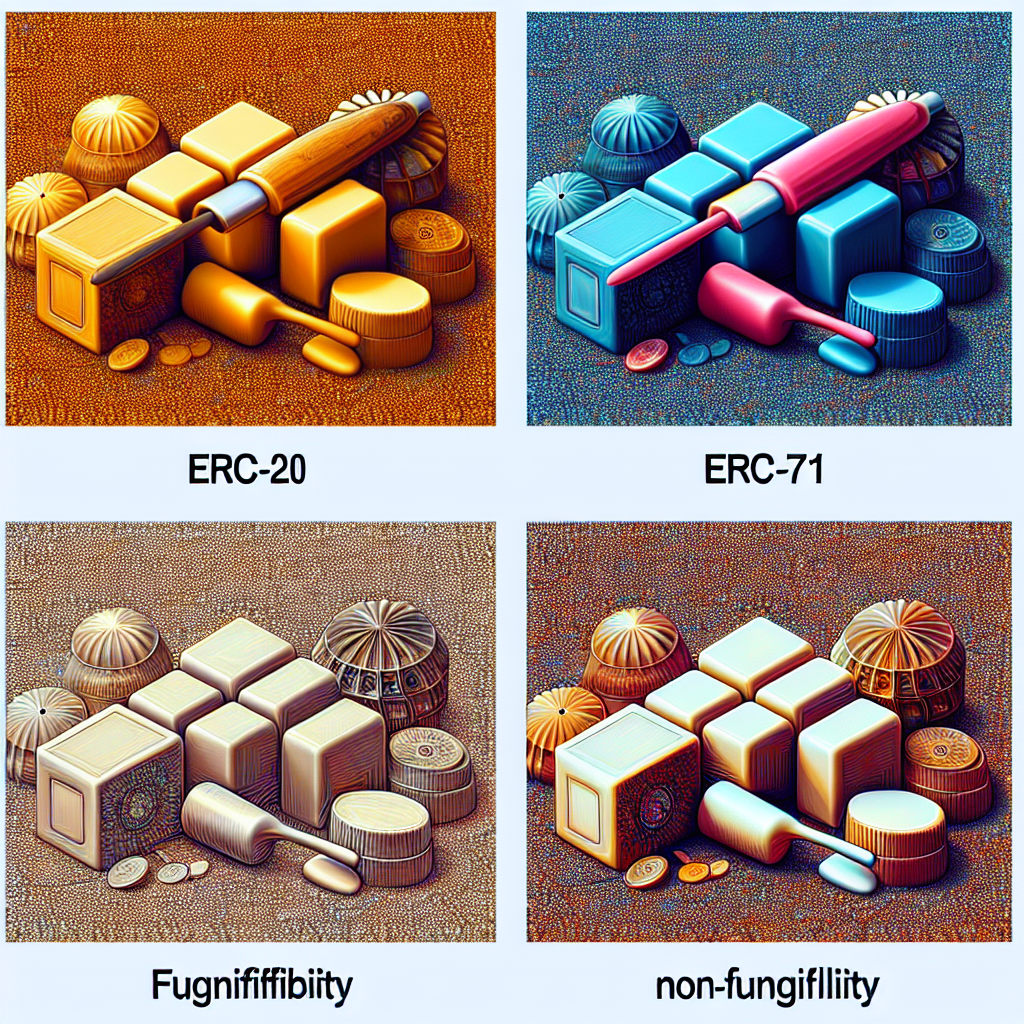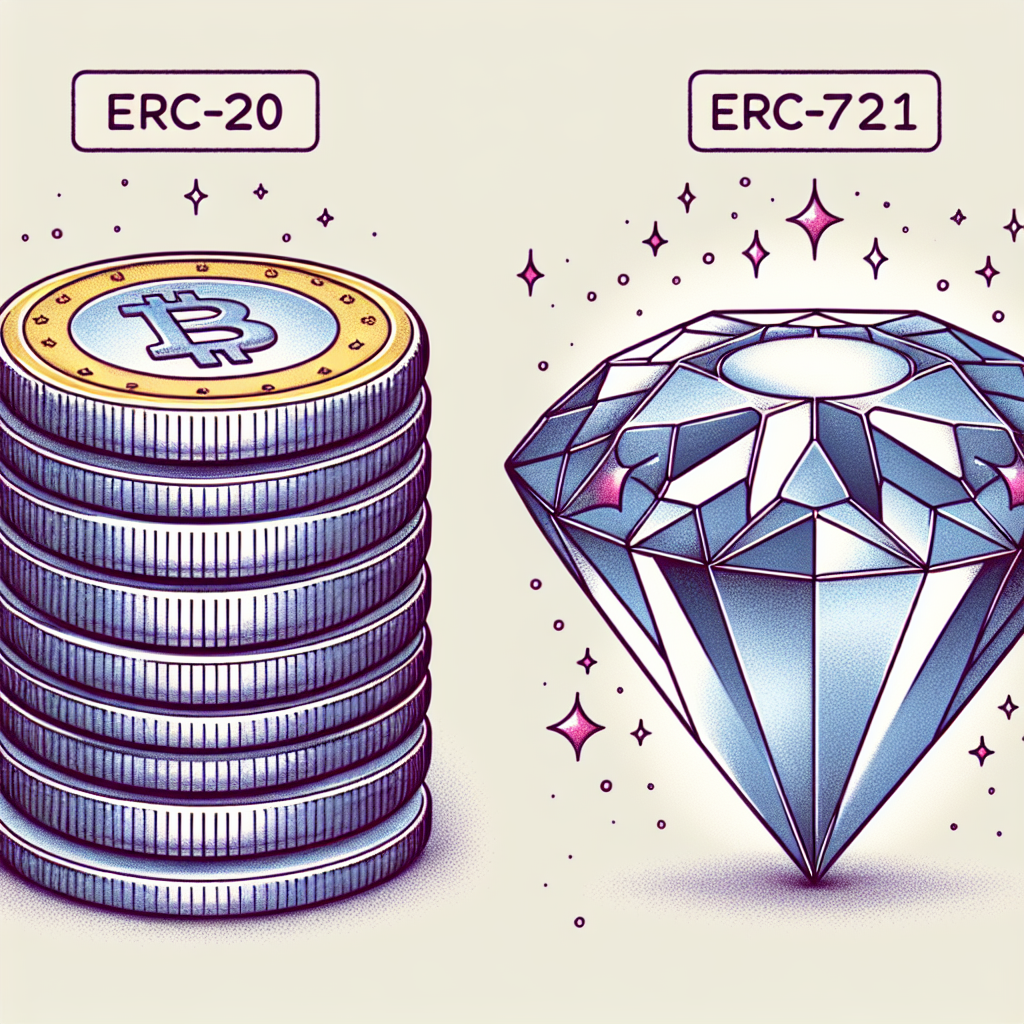In the world of cryptocurrencies, the terms ERC-20 and ERC-721 are often heard but not always fully understood. If you find yourself wondering what sets these tokens apart, you’re not alone. ERC-20 and ERC-721 tokens both exist on the Ethereum blockchain, but their functionalities and purposes differ significantly. So, let’s embark on a journey to explore the differences between ERC-20 and ERC-721 tokens and gain a deeper understanding of these fascinating digital assets.
Overview
In the world of blockchain and cryptocurrency, tokens play a crucial role in enabling various functionalities and transactions. An ERC-20 token is a type of token standard on the Ethereum blockchain, whereas an ERC-721 token is another standard that offers unique characteristics. Both ERC-20 and ERC-721 tokens have their own advantages and limitations, and understanding their differences is essential for anyone involved in the blockchain ecosystem. This article aims to provide an in-depth overview of ERC-20 and ERC-721 tokens, highlighting their definition, characteristics, similarities, differences, advantages, limitations, and future trends.
Definition of ERC-20 Tokens
What is ERC-20?
ERC-20 stands for Ethereum Request for Comment 20, which is a standard interface for tokens on the Ethereum blockchain. It defines a set of rules and functions that tokens must adhere to in order to be compliant with the ERC-20 standard. These rules were established to ensure interoperability between different tokens and to make them easily tradable and usable within the Ethereum ecosystem.
Characteristics of ERC-20 Tokens
ERC-20 tokens share several common characteristics. Firstly, they can be divided into fractional units, allowing for easy trading and liquidity. They also adhere to a predefined list of functions, such as checking an account’s balance, transferring tokens, and approving token transactions. Additionally, ERC-20 tokens can be easily integrated into decentralized applications (dApps) and smart contracts, making them widely used in token sales, initial coin offerings (ICOs), and other blockchain-based projects.

Definition of ERC-721 Tokens
What is ERC-721?
ERC-721, also known as the Non-Fungible Token (NFT) standard, is a token standard on the Ethereum blockchain that enables the creation and ownership of unique, indivisible tokens. Unlike ERC-20 tokens, which are fungible and interchangeable, each ERC-721 token has its own distinct attributes and properties. This uniqueness makes ERC-721 tokens ideal for representing collectibles, digital art, in-game assets, and any other item that requires individuality and scarcity.
Characteristics of ERC-721 Tokens
ERC-721 tokens possess distinct characteristics that set them apart from their ERC-20 counterparts. Firstly, each ERC-721 token has a unique identifier, making them non-fungible and irreplaceable. This uniqueness allows for the creation of limited edition digital assets and collectibles, which can be bought, sold, and traded on various platforms. Additionally, ERC-721 tokens provide verifiable proof of ownership, allowing creators and collectors to prove the authenticity and rarity of their tokens. This is particularly valuable in the realm of digital art and collectibles, where the uniqueness and scarcity of each item contribute to its value.
Similarities between ERC-20 and ERC-721 Tokens
While ERC-20 and ERC-721 tokens have distinct characteristics, they also share some similarities. Both token standards are based on the Ethereum blockchain, which means they benefit from its security, decentralization, and wide adoption within the blockchain community. Furthermore, both ERC-20 and ERC-721 tokens can be bought, sold, and traded on various decentralized exchanges (DEXs) and secondary markets. This allows for liquidity and gives users the flexibility to transact with these tokens as they see fit.

Key Differences between ERC-20 and ERC-721 Tokens
Token Standards
The main difference between ERC-20 and ERC-721 tokens lies in their token standards. ERC-20 tokens adhere to a fungible token standard, where each token is considered equal and can be replaced by another token of the same type without any impact on their value or functionality. On the other hand, ERC-721 tokens follow a non-fungible token standard, meaning each token is unique and cannot be exchanged on a one-to-one basis with another token of the same type.
Transferability and Ownership
Transferability and ownership are significant distinctions between ERC-20 and ERC-721 tokens. ERC-20 tokens are highly transferable, allowing users to easily send, receive, and trade them. They can be divided into fractional units, enabling precise value transfers. In contrast, ERC-721 tokens have one owner per token, and complete ownership of a token can only be transferred as a whole. This makes ERC-721 tokens more suitable for representing items that require individual ownership, such as unique items of digital art or in-game assets.
Individuality of Tokens
The individuality of tokens is a key factor that differentiates ERC-20 and ERC-721 tokens. ERC-20 tokens, being fungible, are identical to one another and cannot be distinguished from each other in any meaningful way. In contrast, ERC-721 tokens have their own distinct attributes and properties, making each token unique and distinguishable. This individuality opens up a wide range of possibilities for creating and trading digital collectibles, in-game assets, and other unique items.
Use Cases
ERC-20 and ERC-721 tokens serve different use cases within the blockchain ecosystem. ERC-20 tokens are widely used for fundraising through ICOs, token sales, and crowd-lending platforms. They are also used as utility tokens within decentralized applications, granting users access to platform features and services. On the other hand, ERC-721 tokens are primarily used for representing ownership and creating digital scarcity. They find applications in the art world, gaming industry, and any other domain where unique, verifiable ownership is desired.
Development Complexity
The development complexity of ERC-20 and ERC-721 tokens also differs. ERC-20 tokens follow a relatively simple and well-established standard, making them easier to develop, deploy, and integrate into existing platforms. In contrast, ERC-721 tokens require additional programming and customization to define the unique attributes of each token. This development complexity raises the barrier to entry and can make ERC-721 token creation and implementation more time-consuming and challenging.
Advantages of ERC-20 Tokens
ERC-20 tokens offer several advantages that contribute to their widespread adoption and use. Firstly, their fungibility allows for easy interchangeability, making them highly liquid and tradable on multiple exchanges. Additionally, ERC-20 tokens benefit from existing infrastructure and tools, making them easier to integrate into dApps and smart contracts. The well-established ERC-20 standard provides a clear set of rules and functions, ensuring interoperability and compatibility across different Ethereum-based projects.
Advantages of ERC-721 Tokens
ERC-721 tokens hold unique advantages that make them highly valuable in specific use cases. Firstly, their individuality and non-fungibility allow for the creation of unique digital assets, collectibles, and in-game items that hold value due to their rarity and authenticity. The verifiable ownership and proof of scarcity provided by ERC-721 tokens increase trust and value within the market. Additionally, ERC-721 tokens open up new revenue streams for artists and creators, enabling them to directly monetize their work without intermediaries.
Limitations of ERC-20 Tokens
Despite their advantages, ERC-20 tokens also have limitations that need to be considered. The fungibility of ERC-20 tokens means that each token is equal and interchangeable, which restricts their use in representing unique items and collectibles. Additionally, the high supply and ease of creating ERC-20 tokens have led to some concerns regarding token utility, value, and tokenomics. Furthermore, the simplified nature of ERC-20 tokens may limit their versatility in more complex use cases and advanced decentralized applications.
Limitations of ERC-721 Tokens
While ERC-721 tokens offer unique characteristics, they also come with limitations. Firstly, their non-fungibility restricts their immediate interchangeability and liquidity when compared to ERC-20 tokens. The transfer of individual ERC-721 tokens requires a more complex process, potentially leading to higher transaction fees. Additionally, the uniqueness and scarcity that make ERC-721 tokens valuable can also limit their wider adoption due to their niche market appeal. ERC-721 tokens may have less utility in certain domains where fungibility and interchangeability are more important.
Future Trends in ERC-20 and ERC-721 Tokens
The future of ERC-20 and ERC-721 tokens is expected to be promising, with further developments and innovations on the horizon. Enhancements to the ERC-20 standard, such as ERC-777, aim to address existing limitations and provide additional functionality and security. Moreover, the popularity of ERC-721 tokens in the digital art and collectibles space has paved the way for new standards and solutions dedicated to this sector. Projects like ERC-1155 have emerged, aiming to combine the advantages of both ERC-20 and ERC-721 tokens, providing a more flexible and efficient token standard.
In conclusion, both ERC-20 and ERC-721 tokens play crucial roles within the blockchain ecosystem, offering distinct characteristics and use cases. ERC-20 tokens provide fungibility, interoperability, and simplicity, making them widely used in fundraising and utility token scenarios. On the other hand, ERC-721 tokens offer individuality, verifiable ownership, and scarcity, making them ideal for representing unique digital assets and collectibles. Recognizing the similarities, differences, advantages, and limitations of these token standards is essential for anyone looking to leverage the power of blockchain technology and tokenization.

